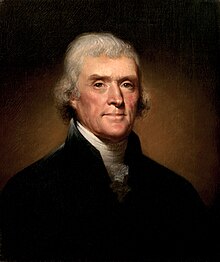📖 Presidential Profile
Comprehensive overview of leadership, policies, and historical significance
📋 Biography & Political Journey
Author of the Declaration and Revolutionary Leader
Thomas Jefferson was born on April 13, 1743, in Shadwell, Virginia, to a wealthy planter family. Educated at the College of William & Mary, Jefferson developed interests in law, philosophy, science, and architecture that would define his remarkable career. As a young lawyer and member of the Virginia House of Burgesses, he quickly emerged as an eloquent advocate for colonial rights against British rule.
Jefferson’s most enduring contribution to American history came at age 33 when he drafted the Declaration of Independence in 1776. His powerful prose, declaring that “all men are created equal” and possess unalienable rights to “life, liberty, and the pursuit of happiness,” articulated the philosophical foundation of American democracy. The document’s influence extended far beyond America, inspiring democratic movements worldwide and establishing Jefferson as one of history’s great champions of human liberty.
During the Revolutionary War, Jefferson served as governor of Virginia and later as minister to France, where he witnessed the early stages of the French Revolution. His experiences in Europe reinforced his commitment to republican government and individual rights, while also exposing him to Enlightenment ideas about science, education, and social progress that would influence his later policies.
Presidential Achievements and Democratic Philosophy
Jefferson’s presidency, beginning in 1801, marked the first peaceful transfer of power between opposing political parties in American history. His inauguration speech emphasized unity, declaring “We are all Republicans, we are all Federalists.” Jefferson’s administration reduced the size and scope of federal government, eliminated internal taxes, and paid down the national debt, reflecting his belief in limited government and individual liberty.
The Louisiana Purchase in 1803 represented Jefferson’s greatest presidential achievement, doubling the size of the United States for $15 million. Although the Constitution did not explicitly grant the federal government power to acquire territory, Jefferson set aside his strict constitutional interpretation to complete this transformative deal with France. The purchase secured American control of the Mississippi River and provided vast territories for westward expansion.
Jefferson’s commitment to education and intellectual advancement led him to establish the University of Virginia in 1819, which he considered one of his greatest accomplishments alongside the Declaration of Independence and the Virginia Statute for Religious Freedom. He designed the university’s buildings, selected its faculty, and created an innovative curriculum emphasizing student choice and academic freedom.
The Contradiction of Slavery
Jefferson’s greatest contradiction lay in his simultaneous advocacy for human equality and his ownership of enslaved people. Despite writing that “all men are created equal,” Jefferson owned over 600 enslaved individuals throughout his lifetime and freed only a few. His relationship with Sally Hemings, an enslaved woman who bore several of his children, represents the complex and troubling intersection of power, race, and intimacy in the slaveholding South.
Jefferson’s racial views, expressed in his “Notes on the State of Virginia,” reflected the prejudices of his time while contradicting his stated principles of human equality. He believed African Americans were intellectually inferior to whites, yet paradoxically feared that slavery’s injustice would eventually provoke divine retribution against America. This contradiction between Jefferson’s ideals and actions continues to complicate his historical legacy.
The Mammoth Cheese Incident
In 1802, Jefferson received a massive 1,235-pound wheel of cheese as a gift from the citizens of Cheshire, Massachusetts. The cheese, dubbed the “Mammoth Cheese,” was made entirely by Republican supporters to show their appreciation for the new president. It took 900 cows to produce enough milk for this enormous creation, which measured over four feet in diameter. Jefferson displayed the cheese in the White House East Room, where it remained for over two years, gradually being consumed at official receptions. The president was so delighted with this unusual gift that he insisted on paying the townspeople $200 for it, despite their intention to offer it freely. The Mammoth Cheese became a symbol of Jefferson’s connection to common citizens and his appreciation for their support, though visitors to the White House often commented on the strong aroma that permeated the building during its residence there.
Humor & Jokes
Declaration of Independence
Jefferson wrote the Declaration of Independence at age 33. Revolutionary writing that changed world history.
Read More →Greatest Wins
🗺️ The Louisiana Purchase - Doubling America's Territory
Jefferson's bold 1803 purchase from France doubled the nation's size for just $15 million, securing…
Read More →Epic Fails
⚖️ The Alien and Sedition Acts Response Crisis
Jefferson's Kentucky Resolutions challenged federal authority so radically they nearly provided a blueprint for states…
Read More →